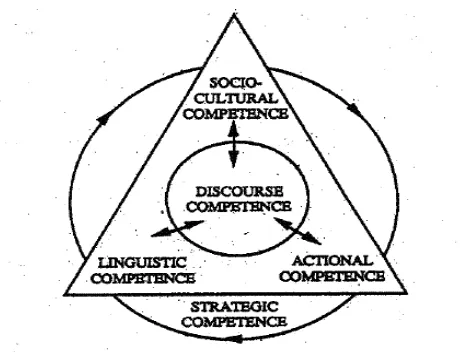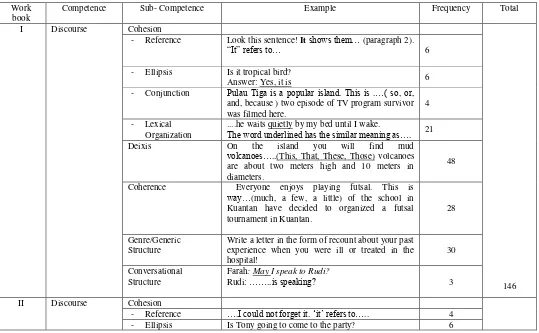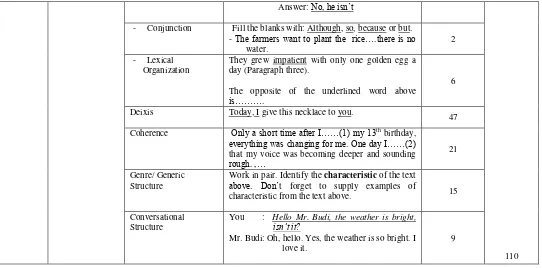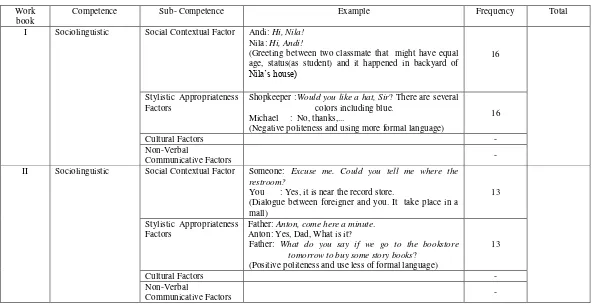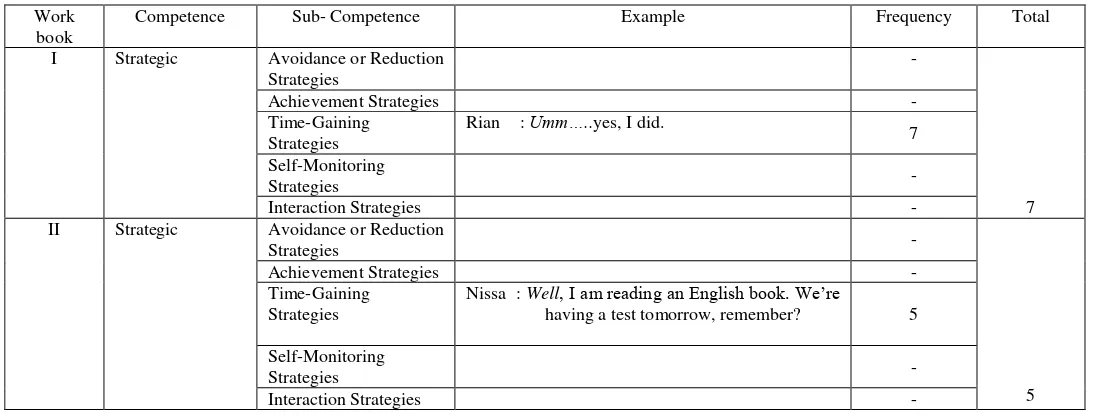THESIS
ENGLISH TASK TO DEVELOP
THE STUDENTS’ COMMUNICATIVE COMPETENCE:
A STUDY OF
EDUKATIF
WORK BOOK FOR JUNIOR HIGH
SCHOOL STUDENTS
MANUSCRIP PUBLICATION
Submitted as a Partial Fulfillment of the Requirement for the Master Degree in Language Study at Muhammadiyah University of Surakarta
by
DYAH ROHMA WATI S.200 090 012
MAGISTER OF LANGUAGE STUDY
ii
APPROVAL
ENGLISH TASK TO DEVELOP
THE STUDENTS’ COMMUNICATIVE COMPETENCE:
A STUDY OF EDUKATIF WORK BOOK FOR JUNIOR HIGH SCHOOL
STUDENTS
Manuscript Publication
by
DYAH ROHMA WATI
S 200 090 012
The Manuscript Publication Has Been Approved by Board of Consultants of English
Language Study, Graduate School of Muhammadiyah University of Surakarta, on
May 2012
1
ENGLISH TASK TO DEVELOP
THE STUDENTS’ COMMUNICATIVE COMPETENCE: objective of this research is to explain what extent tasks in Edukatif work books are designed to develop students‟ discourse competence, linguistic competence, actional competence, sociolinguistic competence, and strategic competence.
This research is qualitative research which involves content analysis approach. The object of this research is English work book named Edukatif that published by Akik Pusaka Sragen. The writer analyzes the work book of eight grade students including the work book that used in the first and second semester. In collecting the data, the writer uses documentation method. The data analyze used the theory of Hiberman and Miles which involves data reduction, data display and verification.
The findings show that among the five competences and its components of communicative competence, some components are not developed in both work books. Both Edukatif work book one and two can develop all components of discourse competence. But the tasks do not develop one aspect in linguistic competence that is phonology. Moreover, work book one and two can develop most component of actional competence, except speech act (in work book one) and problem key area (in work book two). Some tasks in both work books also develop two components- among four components-of sociolinguistic competence, except cultural and non-verbal communicative factor. Latter, the work book only develop one component-among five components- of strategic competence that is time and gaining strategy. So, considering the result above, the writer can conclude that the tasks in both Edukatif work books are not sufficient to develop the students‟ communicative competence, especially in developing sociolinguistic and strategic competence.
2
1. Introduction
Learning material plays important role in English language teaching. It
provides anything which is used by teacher or learner to facilitate and support
the language learning. There are many kinds of learning materials including
cassette, videos, CD-Rooms, dictionaries, grammar books, readers, work
books, photocopied exercises, newspapers, etc (Tomlinson, 1998:2).
The contents of learning material in EFL learning context always
changes, which is due to the influence of the Indonesian government policy
about the change of curriculum in the secondary education level. As materials
are components of curriculum, they should comply with the curriculum
guidelines. According to Sukmadinata (2008:103-110) there are some
components of curriculum, namely; aim, material, teaching strategy, teaching
media, and teaching evaluation.
Nowadays, common learning materials used by English teachers are
text books and work books. In fact, teachers often use work books rather than
text books as compulsory materials for the students because they help
teachers to teach a lesson-in which there is summary of materials- and
provide some tasks for students. According to Tomlinson (1998: xiii) work
book is a book which contains extra practices for learners to work on in their
own time.
The use of work book is inclined on the use of its tasks. According to
Breen in Nunan 1989: 6 “ Tasks is assumed to refer to a range of work plans which have the overall purpose of facilitating language learning- from the
simple and brief exercise type, to more complex and lengthy activities such
as group problem solving or simulations and decision making”. The tasks in
the work book used by teacher as source of exercises in each material.
Indonesian government has implemented many model of curriculum.
Recently, Curriculum in the Unit Level of Education (Kurikulum Tingkat
Satuan Pendidikan) or KTSP is introduced. It is common that in KTSP
curriculum, English teachers should develop students‟ communicative
3
Number: 22 / Year 2006 (number I) stated that the Content Standard for the
English language learning in Junior secondary school should develop
students‟ language skills which can enable them to communicate in spoken and written English.
The description of Curriculum and Regulation above shows that
language learning in Junior secondary school emphasize to develop students‟
communicative competence in which the model of communicative
competence by Celce-Murcia, Thurrell, and Dornyei(1995) is applied.
Communicative competence can be gotten only through its supporting
competence, namely, linguistic competence, actional competence,
sociocultural competence, and strategic competence. The pedagogical
implication is that formulating English competence and its indicator that used
in English language learning based on the competence above. Therefore, the
indicator in curriculum as well as the work book should develop the five
competences and its components.
Nowadays, there are many kinds of work book used in Indonesian EFL
learning context. Here, the writer analyzes work book entitled Edukatif at the
eight grades of Junior high school students in Sragen which is published by
Akik Pusaka.
Based on the explanation above, the problem of this study is to what
extent tasks in Edukatif work book are designed to develops students‟
communicative competence. Considering there are five components of
communicative competence, the subsidiary question of the research question
above is “To what extent are tasks in Edukatif work book designed to develop
students‟ (1) discourse competence, (2) linguistic competence, (3) actional
competence, (4) sociolinguistic competence, and (5) actional competence”?.
Thus, the objective of this study is to describe what extent tasks in Edukatif
work book are designed to develop the five competences.
4
1.1 Communicative Competence
The term communicative competence was coined by Dell Hymes
in 1966 who defined it as the knowledge of both rules of grammar and
rules of language use appropriate to a given context, reacting against the
perceived inadequacy of Noam Chomsky‟s distinction between
competence and performance (1965). Much of Hymes‟ justification of this theory is based on his criticism of Chomsky‟s linguistic competence.
Later, Cook (1997:117) defines communicative competence as the ability
to use language effectively to communicate in particular context and for
particular purposes.
The notion of communicative competence has been evolving for
years. In short, the development of the concept of communicative
competence can be drawn as follows:
a) Chomsky (1957, 1965) linguistic competence
b) Dell Hymes (1967, 1972) generalized communicative competence into
(1) whether (and to what degree) something is possible. (2) Whether
(and to what degree) something is feasible. (3) Whether (and to what
degree) something is appropriate. (4) Whether (and to what degree)
something is done.
c) Canale and Swain (1980) competence (grammatical, sociolinguistic,
discourse and strategic competence)
d) Bachman (1980) competence (language competence, strategic
competence, and psychophysiological mechanism)
e) Celce Murcia, Dörnyei and Thurrel (1995) further refined the model by
making finer distinctions in the area of sociolinguistic competence: (1)
linguistic competence (not narrowly grammar); (2) strategic
competence (efficiency and recovery); (3) sociocultural competence
(non-linguistic knowledge for appropriate deployment of linguistic
resources); (4) actional competence (carrying out/ understanding
communicative intent by performing and interpreting speech acts and
5
concerns the selection, sequencing of linguistic items (words,
structures, sentences, utterances) to achieve a unified spoken/ written
text.
1.2. The Component of Communicative Competence by Celce-Murcia, Dornyei, Thurrell
The latest model of communicative competence is proposed by
Celce-Murcia, Dornyei and Thurrell. It is represented in a pyramid
enclosing a circle and surrounded by another circle as bellow:
Figure 1. Schematic Representation of Communicative Competence (Celce-Murcia et al. 1995:10)
The figure above shows that the main competence in language
learning is Discourse Competence. It means that if people involved in such
communication whether in oral or written form, they involved in cultural
and situational context that cover it. To gain discourse competence people
need to develop its supporting competence, such as linguistic competence,
actional competence, sociocultural competence, and strategic competence.
Moreover, each competence above is divided into sub- component (micro
competence) which is used as guide in language learning (Fauziati &
Hikmat, 2009:8-9).
The Pedagogical implication is that in formulating the competences
6
in order to achieve discourse competences in educational process.
Therefore, the indicator which is stated in curriculum decided based on the
five competences. Here is the explanation of the five competences:
a. Discourse Competence
Discourse Competence concerns the selection, sequencing, and
arrangement of word, structure, sentences, and utterance to achieve a
unified spoken or written text Celce-Murcia et al (1995: 13). There are
many sub-areas that contribute to discourse competence, they are
cohesion, deixis, coherence, genre, and the conversational structure.
b. Linguistic Competence
Linguistic competence is the mastery of language code, the ability
to use grammar, syntax and vocabulary. This competence encompasses
knowledge of roles of phonology, morphology, lexical items, and syntax
(Brown, 2000: 247).
c. Actional competence
Actional competence is defined as competence in conveying and
understanding communicative intent, that is, matching actional intent
with linguistic form based on the knowledge of inventory of verbal
schemata that carry illocutionary force (speech act and speech act sets).
The conceptual of actional competence domain divided into two main
components, knowledge of language function and knowledge of speech
act. Therefore, actional competence also involves knowledge of how
speech act and language function can be pattern and sequenced in real
life situation (Celce-Murcia, et.al., 1995: 20-21).
d. Sociolinguistic Competence
Sociolinguistic competence refers to the speaker‟s knowledge of how to express message appropriately within the overall social and
cultural context of communication, in accordance with the pragmatic
factors related to variation in language use. Celce-Murcia et al (1995:23)
7
categories, namely, social contextual factors, stylistic appropriateness
factors, cultural factors, and non-verbal communicative factor.
e. Strategic Competence
Strategic Competence conceptualized as knowledge of
communication strategies and how to use them. In other word, it is the
ability to solve communication problems despite an inadequate
command of the linguistic and sociocultural code. According to
Celce-Murcia et al (1995, 28) this competence consist of five main parts ,
namely, avoidance and reduction strategies, achievement and
compensatory strategies, stalling and time gaining strategies,
self-monitoring strategies, and interactional strategies.
2. Research Method
This study applies qualitative method. Bogdan and Taylor in
Moelong (2007: 4) said that qualitative method is research procedure that
yield descriptive data in the form of written or oral speech and observable
behavior. The approach used for this research is content analysis. This
analysis closely associates with qualitative research. Indeed, qualitative
content analysis also said as „latent level analysis‟, because it concerns
second-level, interpretative analysis of the underlying deeper meaning of
the data (Dornyei, 2007: 245-246).
The data of this research are some tasks that are written in the work
book. The source of data is English work book / Edukatif of the eight grade
Junior high school students and published by Akik Pusaka Sragen. This
research includes the work book for the first and second semester. Each
work book consists of three chapters related to certain theme. Here, the
writer focuses on discussing some tasks that are covered in those three
chapters.
The technique used to collect the data is documentation method.
There are some procedures in applying this method.
8
b. She marks the tasks that are thought can develop the target competences.
c. She gives code on the marked materials in accordance with the
developed competence.
d. She notes the page and number of the tasks that develops the
competence.
e. She accounts amount of the tasks that develop the competence
After collecting the whole data, the next step is analyzing the data.
Huberman and Miles (1994: 10) mention three linked processes of analysis,
namely, a) data reduction, b) data display, and c) data conclusion drawing
and verification. The process of analyzing data is described in the figure
below.
Figure 2. Components of Data Analysis: Interactive Model (Huberman and Miles, 1994: 12)
3. Research Findings
The findings of the research are displayed in the table below. They are
displayed based on the competence developed and followed by the example of
the tasks.
Data
Collection Data
Display
Data
Reduction Conclusion:
The Frequency of the Tasks to Develop Students’ Discourse Competence.
The following table is the frequency of both Edukatif work books in providing tasks to develop the students‟ discourse
competence.
Table 4.1.Frequency of ‘Edukatif’ Work Book in Providing Tasks to Develop Students’ Discourse Competence.
Work book
Competence Sub- Competence Example Frequency Total
I Discourse Cohesion
146 - Reference Look this sentence! It shows them…(paragraph 2).
“It” refers to… 6
- Ellipsis Is it tropical bird?
Answer: Yes, it is 6
- Conjunction Pulau Tiga is a popular island. This is .…( so, or, and, because ) two episode of TV program survivor was filmed here.
4
- Lexical Organization
....he waits quietly by my bed until I wake.
The word underlined has the similar meaning as…. 21
Deixis On the island you will find mud
volcanoes…..(This, That, These, Those) volcanoes are about two meters high and 10 meters in
Write a letter in the form of recount about your past experience when you were ill or treated in the
II Discourse Cohesion
- Reference ….I could not forget it. „it‟ refers to….. 4
- Ellipsis Is Tony going to come to the party? 6
Answer: No, he isn‟t
110 - Conjunction Fill the blanks with: Although, so, because or but.
- The farmers want to plant the rice….there is no
Deixis Today, I give this necklace to you.
47
Coherence Only a short time after I……(1) my 13th birthday,
everything was changing for me. One day I……(2)
that my voice was becoming deeper and sounding
rough. ,…
21
Genre/ Generic Structure
Work in pair. Identify the characteristic of the text
above. Don‟t forget to supply examples of
characteristic from the text above. 15
Conversational Structure
You : Hello Mr. Budi, the weather is bright,
isn’t it?
Mr. Budi: Oh, hello. Yes, the weather is so bright. I love it.
9
The Frequency of the Tasks to Develop Students’ Linguistic Competence.
The following table is the frequency of both Edukatif work books in providing tasks to develop the students‟ linguistic
competence.
Table 4.2. Frequency of ‘Edukatif’ Work Book in Providing Tasks to Develop Students’ Linguistic Competence.
Work book
Competence Sub- Competence Example Frequency Total
I Linguistic Phonology -
Morphology A dog run fast but a horse is faster
2
1
Lexicon Complete the sentences with the correct words! - When the harvesting time, the farmer has
abundant of rice.
19
27 Syntax Change into negative and interrogative sentences.
- Mother plants the flowers in the garden. 6
II Linguistic Phonology -
40 Morphology Change the following regular verb into past forms!
1. lie 2. describe
7
Lexicon Find the Indonesia meaning of the underlined phrase on the text above!
- the entrance gate -walked around
22
Syntax Arrange these sentences into the correct orders!
- are- as–sky- blue- as- eyes-the 11
The Frequency of the Tasks to Develop Students’ Actional Competence.
The following table is the frequency of both Edukatif work books in providing tasks to develop the students‟ actional
competence.
Table 4.3. Frequency of ‘Edukatif’ Work Book in Providing Tasks to Develop Students’ Actional Competence.
Work book
Competence Sub- Competence Example Frequency Total
I Actional Knowledge of
- Information Complete the dialogue below?
Mr. John : Thank you very much, Sir. By the way, can you tell me how to get the subway station from the bank?
6
- Opinion Choose the correct answer by giving cross on a, - Feelings Practice the dialogue below!
Yohana: Novi, tomorrow is a holiday. How
- Problems Yani: Ani, where is my eraser? you borrowed it
yesterday, didn‟t you? can do our homework together. Leo :Yes, certainly. We can discuss it
together.
25
- Information Someone : Excuse me, Could you tell me 4
where the rest room is? You : Yes, it is near the record store.
53
- Opinion Complete the dialogue with suitable
expressions!
Adi : What do you think of the story of Malin Kundan?(asking)
Sanusi : I think the story is very touching.
15
- Feelings Dhea : Yes, it is. Nice weather we‟re having.
Jack : Look! This is a fantastic sight. 2
- Suasions Shinta : Dad, can I go to Diana’s party tonight? Tomorrow is holiday. I don‟t have any
homework.
1
- Problems -
- Future Scenario Jack : The weatherman says it will be sunny today.
Dhea : Really, Let‟s go camping then,…
5
Knowledge of Speech Act
Shafa : It is hot today.
Gita : Would you like a glass of ice?
Shafa :Yes, please I like it very much.
1
The Frequency of the Tasks to Develop Students’ Sociolinguistic Competence.
The following table is the frequency of both Edukatif work books in providing tasks to develop the students‟ sociolinguistic
competence.
Table 4.4. Frequency of ‘Edukatif’ Work Book in Providing Tasks to Develop Students’ Sociolinguistic Competence.
Work book
Competence Sub- Competence Example Frequency Total
I Sociolinguistic Social Contextual Factor Andi: Hi, Nila!
Nila : Hi, Andi!
Shopkeeper :Would you like a hat, Sir? There are several colors including blue.
Michael : No, thanks,...
(Negative politeness and using more formal language)
16
tomorrow to buy some story books?
(Positive politeness and use less of formal language)
13
Cultural Factors -
Non-Verbal
Communicative Factors -
The Frequency of the Tasks to Develop Students’ Strategic Competence.
The following table is the frequency of both Edukatif work books in providing tasks to develop the students‟ strategic
competence.
Table 4.5. Frequency of ‘Edukatif’ Work Book in Providing Tasks to Develop Students’ Strategic Competence. Work
book
Competence Sub- Competence Example Frequency Total
I Strategic Avoidance or Reduction
Strategies
-
7
Achievement Strategies -
Time-Gaining Strategies
Rian : Umm…..yes, I did. 7
Self-Monitoring
Strategies -
Interaction Strategies -
II Strategic Avoidance or Reduction
Strategies -
5
Achievement Strategies -
Time-Gaining Strategies
Nissa : Well, I am reading an English book. We‟re
having a test tomorrow, remember? 5
Self-Monitoring
Strategies -
Interaction Strategies -
1
16
4. Discussion
Among the five competences of communicative competence, work book
one provides the tasks that develop all component of discourse competence (146
tasks). The work book also provides some tasks that develop students‟ ability in
linguistic competence (27 tasks), but there is one component that is not developed
in the work book that is phonology. There are some tasks in work book one
related to actional competence (68 tasks), but speech act does not appear in the
tasks. The work book also provide some tasks that develop students ability in
sociolinguistic (16 tasks), but there are two components that do not appear in the
tasks, they are cultural and non verbal communicative factors. In strategic
competence, work book one only provides the tasks that develop one component
of this competence that is stalling and time gaining strategy (7 tasks).
Edukatif work book two also provides some tasks that develop students‟
ability in discourse competence and all of its components (110 tasks). The work
book also provides some tasks related to linguistic competence (40 tasks), but
there is one component that does not state in the work book that is phonology. In
actional competence, the work book also provides some tasks that develop this
competence (53 tasks), but problem key area of language function does not appear
in the work book. The work book also provides some tasks that develop students‟
ability in sociolinguistic competence (13 tasks), but there are two components that
do not appear in the tasks, they are cultural and non verbal communicative factor.
Latter, the tasks in work book two only develop one component of actional
competence that is stalling and time gaining strategy (5 tasks).
Based on the findings, the researcher determines that the tasks in both
Edukatif work books are not totally extend to develop students‟ communicative
competence. It considers among the five competences and its components of
communicative competence, there are components that are not developed in both
work books they are some components of sociolinguistic and actional
17
5. Conclusion and Suggestion Conclusion
After analyzing the tasks in both Edukatif work books, the writer
finds that-among the five competences of communicative competence and
their components- the tasks in both work books can develop all components of
discourse competence. But the tasks do not develop one component in
linguistic competence that is phonology. Moreover, work book one and two
can develop most component of actional competence, except speech act (in
work book one and problem key area (in work book two). Some tasks in the
work books also develop two components- among four components-of
sociolinguistic competence, except cultural and non-verbal communicative
factor. Latter, the work book only develop one component-among five
components- of strategic competence that is time and gaining strategy.
From the discussion above, the writer can conclude that the tasks in
both Edukatif work books are not sufficient to develop the students‟
communicative competence. Especially, the tasks are lack to develop
sociolinguistic and strategic competence. In fact, both competences are
important aspect that should be developed in order to foster students‟ ability to
communicate appropriately within overall social and cultural context; and also
to use some strategies to compensate the limitation of their language
competence.
Suggestion
There are some suggestions given to those who are related to provide
tasks for developing students‟ communicative competence, they are:
1. For Other Researcher
The writer hopes that this study can be stepping stone for other
researchers who are interested to do a research related to this study. They
can focus the research in each domain of communicative competence in
order to get deeper findings. In addition, the next researcher can do a
18
such as The Indicator of School Based Curriculum, The Indicators that
suggested by some linguists, etc.
2. For the Teacher
Considering the work book is one of learning material and as
source of tasks for the students, English teacher should be able to identify
that the work book can develop all components of communicative
competence. By doing this, the teacher know to what extent the tasks in
work book are designed to develop the competence and can complement it
by taking another source of learning material.
3. For the Writer of the Work book
The finding of this research show that the tasks in both Edukatif
work books are not totally develops some components of communicative
competence. So, the duty of work book writer is to develop some tasks in
both work books in order to develop all components of communicative
competence. More specifically, they can observe types of tasks that are
suitable for developing the components of sociolinguistic and strategic
19
BIBLIOGRAPHY
Brown, H. Douglas. 2000. Principle of Language Learning and Teaching (fourth edition).…….: Longman.
Celce-Murcia, Marianne, et al. 1995. Communicative Competence: A Pedagogically Motivated Model with Content Specification. Applied Linguistics. 6(2): 9-29.
Dorney, Zoltan. 2007. Research Method in Applied Linguistic. New York: Oxford University Press.
Fauziati, E & Hikmat, M. H. 2009. Pendalaman Materi Pelajaran Bahasa Inggris. Panitia Sertifikasi Guru Rayon 41 Surakarta: Depdiknas.
Giyanto. 2009. Materials for Developing Students’ Communicative Competence:
A Textbook Content Analysis. Thesis. Surakarta: Muhammadiyah University of Surakarta.
Huberman, A. M and Miles, M. B. 1994. Qualitative Data Analysis: An Expanded Sourcebook. California: Sage Publication.
Moelong. 2007. Metode Penelitian Kualitatif. Bandung: PT Remaja Rosdakarya.
Nunan, David. 1989. Designing Tasks for Communicative Classroom. New York: Cambridge University Press.
